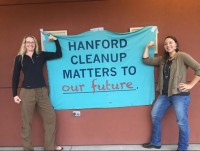Dr. Terrills, Hanford cleanup advocate, just completed a 225-mile peace walk from Portland to Hanford
By Abigail Cermak, Hanford Coordinator

I first met Ceiridwen in the summer of 2014 on Columbia Riverkeeper’s annual Hanford Reach paddle trip. What I remember most was her graceful, thoughtful spirit and her quiet intensity as she toured the B Reactor. Later, I would notice that same intensity as we paddled down the Columbia River past the nine now defunct nuclear reactors on the Hanford site. Since meeting Ceiridwen on that trip, I’ve come to learn that not only is Hanford deeply rooted in her family’s history but she is also an invaluable Hanford cleanup advocate.
This month Ceiridwen completed a 10-day, 225-mile peace walk from Portland, Oregon to the Hanford Nuclear Reservation with the intent of raising awareness about nuclear weapons and the cleanup challenges that remain at Hanford. On her journey, she stopped in White Salmon, WA to speak to a crowd of over 40 people about her walk and the importance of encouraging the public to get involved with cleanup decisions. She also connected with individuals in several other towns along the way to listen to their own stories and concerns about Hanford.
Her inspiration to walk to Hanford came after a visit to Japan this summer for commemoration ceremonies marking the 70th anniversary of the atomic bombings of Hiroshima and Nagasaki. There she gathered the stories of hibakusha, bomb survivors, and had the opportunity to participate in a pilgrimage to the Peace Park that began at Urakami Cathedral near the Nagasaki bomb site. Her decision to travel to Japan stemmed from her own family’s loss related to the atomic bomb. During the 1950s Terrill’s grandfather, an Oklahoma tenant farmer and pipefitter, uprooted the family to work at the Hanford Nuclear Reservation. Promises of a stable government job and security for his family quickly faded when he was laid off and then later passed away at a young age. His youngest son, Terrill’s father, would also die young at the age of 31 of Hodgkin’s Lymphoma when Ceiridwen was only 5 years old.
Growing up, Ceiridwen remembers hearing about “That Hanford Place” from her family but was unable to make sense of what that meant. It wasn’t until 2005, when she was invited to attend her late father’s high school reunion in Grand View that she began to understand how much Hanford had affected nearby communities. During that reunion, it dawned on Ceiridwen that many of her father’s classmates had passed away from various cancers, cancers that their parents and siblings also had, and cancers that afflicted her own family. From then on, Ceiridwen immersed herself in learning about Hanford and began advocating for the cleanup needed to protect other communities and future generations from Hanford’s nuclear legacy.
As often as possible, Ceiridwen visits the Tri-Cities and the Hanford site. Her visits sometimes involve taking a Department of Energy led site tour, or simply driving the old roads her grandfather had taken to work. She takes the opportunity to attend local public meetings about Hanford and believes that her voice in the room is one of the best ways she can be of service to Hanford cleanup. She also uses her position as an educator to increase awareness about Hanford and build bridges to prepare the next generation that will inherit this site. At Concordia University in Portland, where she teaches non-fiction science and nature writing, she talks about Hanford with her classes and incoming freshman. She believes that increasing the awareness of a younger generation will ensure Hanford cleanup stays on track. Ultimately, for Ceiridwen, Hanford cleanup will occur if we can open up the conversation to more of the public and continue to encourage people to get involved.
Ceiridwen is currently working on a book about growing up during the Cold War, her family’s connection to the Hanford Nuclear Reservation, and how she he is trying to navigate toward making sense of the world while remaining a force for positive change. According to Ceiridwen, the book is not meant to be about the history of Hanford. Rather, she hopes to look at some key aspects of Hanford, share some absurd and humorous (in a dark way) stories about its past, and to show the folly of what was and still is happening. She believes we are hard-wired to both tell and hear stories and wants to humanize Hanford, inviting people in to the discussion without being put off by scientific jargon. In the end, she wants a counter-narrative to the wartime pride that is prevalent to Hanford history.
As of this post, Ceiridwen is already planning her next action to help increase awareness for Hanford. She wants to put together another walk to Hanford. Instead of going solo, she wants more people involved in the journey. The idea would be to have people walk shorter distances, passing a baton from one person to the next until the baton reaches Hanford. This action would be symbolic of passing Hanford cleanup on to the next generation, and that we’re all doing our part. Because that is what a successful cleanup looks like.
When she’s not teaching, writing, or thinking about ways to get involved with Hanford, Ceiridwen is a hunter-jumper, where she trains horses and competes in jumping. Her other deep loves include wilderness trekking, back-packing, mountaineering, and spending time with her husband and three dogs. She has authored two memoirs/scientific studies: Part Wild (Scribner), which was a finalist for the 2013 Oregon Book Award, and Unnatural Landscapes: Tracking Invasive Species (University of Arizona Press).
Thank you, Ceiridwen, for all that you do! You have put your best foot forward and are doing good and extraordinary things. We are proud to call you a Riverkeeper.


